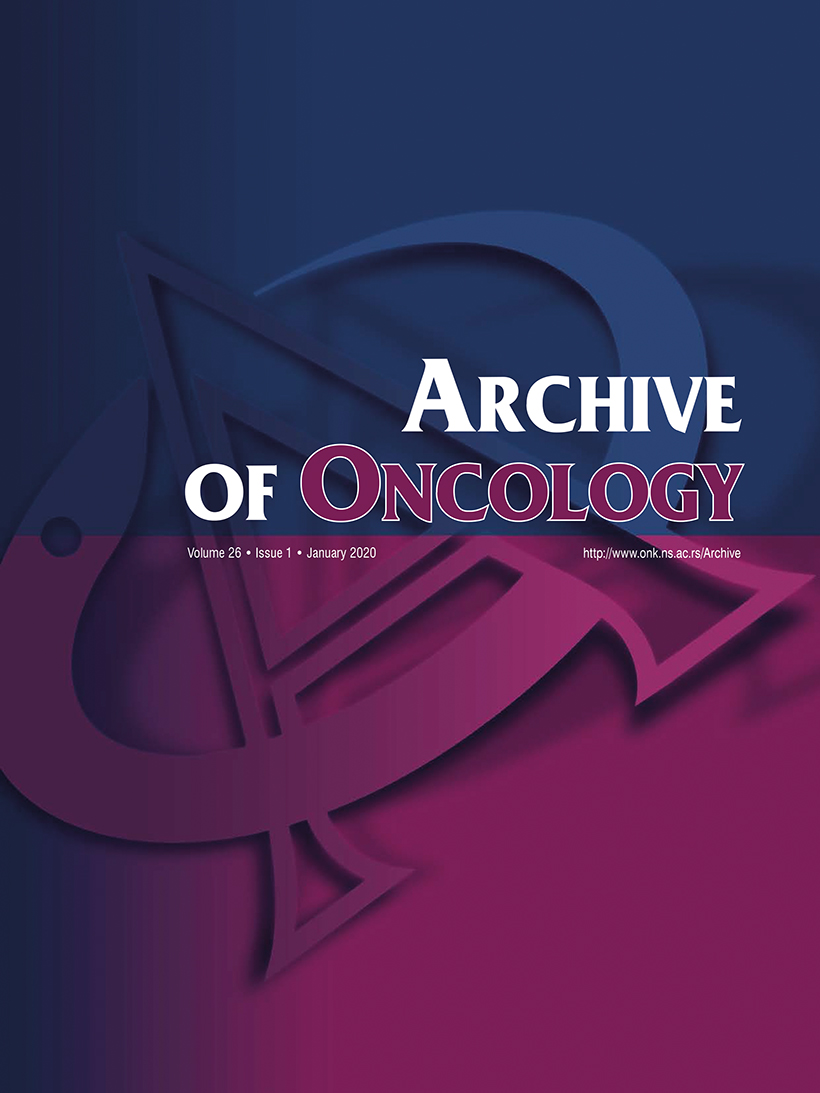Epidemiological and pathological characteristics of post-surgical cases of invasive breast cancer among ethnicities of Iran in 2018: A single center cross-sectional study
Abstract
Background: Present study aimed to investigate immunohistochemical parameters in post-surgical cases of invasive breast cancer. Methods: In this single center cross-sectional study we investigated ethnicity, familial history, type of cancer, stage of cancer, lymph node positivity, bilateral involvement, metastasis and immunohistochemical parameters (estrogen and progesterone receptor, human epidermal growth factor receptor 2, as well as frequency of triple positive and triple negative patients merely based on immunohistochemical parameters). Results: Frequency of positive familial history was 27.42% (16.31-38.52%). Lymph node involvement was detected in 55.93% (43.26-68.60%) of the cases. Frequency of positive HER2 was 38.60% (25.96-51.23%). There were 17.54% (7.67-27.42%) of triple positive and 7.02% (0.39-13.65%) of triple negative cases. The most common stage at the time of diagnosis was stage 3 with 43.33% (30.79-55.87%) frequency. In Lur/Lak population higher frequency of positive HER2 cases was detected whereas in Mazani population frequency of positive HER2 cases was low (p=0.0291). Conclusion: These results could contribute to understanding of breast cancer patterns among different ethnicities. In order to draw clear conclusion future investigations have to be done in several health centers, for longer time periods and with larger number of patients.
References
Mousavi SM, Gouya MM, Ramazani R, Davanlou M, Hajsadeghi N, Seddighi Z. Cancer incidence and mortality in Iran. Annals of Oncology 2008;20(3):556-563. doi: 10.1093/annonc/mdn642
Jazayeri SB, Saadat S, Ramezani R, Kaviani A. Incidence of primary breast cancer in Iran: Ten-year national cancer registry data report. Cancer Epidemiology 2015;39(4):519-527. doi: 10.1016/j.canep.2015.04.016
Jafari-Koshki T, Schmid VJ, Mahaki B. Trends of Breast Cancer Incidence in Iran During 2004-2008: A Bayesian Space-time Model. Asian Pacific Journal of Cancer Prevention 2014;15(4):1557-1561. doi: 10.7314/apjcp.2014.15.4.1557
Akbari ME, Sayad S, Sayad S, Khayamzadeh M, Shojaee L, Shormeji Z, Amiri M. Breast Cancer Status in Iran: Statistical Analysis of 3010 Cases between 1998 and 2014. International Journal of Breast Cancer 2017:1-10. doi: 10.1155/2017/2481021
Akbari ME, Akbari A, Nafissi N, Shormeij Z, Sayad S, Rohani RM, Shojaee L. Prognostic Factors of Recurrence (Early and Late) and Death in Breast Cancer Patients in Iranian Women. Iranian Journal of Cancer Prevention 2016;In Press(In Press) doi: 10.17795/ijcp-5747
Marmot MG, Altman DG, Cameron DA, Dewar JA, Thompson SG, Wilcox M. The benefits and harms of breast cancer screening: an independent review. British Journal of Cancer 2013;108(11):2205-2240. doi: 10.1038/bjc.2013.177
Anbari K, Ahmadi SAY, Baharvand P, Sahraei N. Investigation of breast cancer screening among the women of Khorramabad (west of Iran): a cross-sectional study. Epidemiology Biostatistics and Public Health. 2017;14(1):e12099-1.
Sehhatie SF, Nagizadeh S, Valizadeh S. Breast Cancer Screening Tests in Tabriz Behbood Hospital. International Journal of Women's Health and Reproduction Sciences 2016;4(3):134-140. doi: 10.15296/ijwhr.2016.31
Atashkhoei S, Fakhari S. Management of breast cancer related lymphoedema. Crescent J Med Biol Sci. 2016;3:111-2.
Ridner SH, Dietrich MS, Kidd N. Breast cancer treatment-related lymphedema self-care: Education, practices, symptoms, and quality of life. Supportive Care in Cancer 2011;19(5):631-637. doi: 10.1007/s00520-010-0870-5
Wei Z, Er-li G, Yi-li Z, Qi Z, Zhang-yong Z, Gui-long G, Xiao-hua Z. Different distribution of breast ductal carcinoma in situ, ductal carcinoma in situ with microinvasion, and invasion breast cancer. World Journal of Surgical Oncology 2012;10(1):262. doi: 10.1186/1477-7819-10-262
Rosa M. Advances in the Molecular Analysis of Breast Cancer: Pathway toward Personalized Medicine. Cancer Control 2015;22(2):211-219. doi: 10.1177/107327481502200213
Harirchi I, Ebrahimi M, Zamani N, Jarvandi S, Montazeri A. Breast cancer in Iran: a review of 903 case records. Public Health 2000;114(2):143-145. doi: 10.1038/sj.ph.1900623
Harirchi I, Karbakhsh M, Kashefi A, Momtahen AJ. Breast cancer in Iran: results of a multi-center study. Asian pacific journal of cancer prevention. 2004;5(1):24-7.
Sadjadi A, Nouraie M, Ghorbani A, Alimohammadian M, Malekzadeh R. Epidemiology of breast cancer in the Islamic Republic of Iran: first results from a population-based cancer registry. La Revue de Santé de la Méditerranée orientale. 2009;15(6):1426-31.
Mahdavifar N, Pakzad R, Ghoncheh M, Pakzad I, Moudi A, Salehiniya H. Spatial Analysis of Breast Cancer Incidence in Iran. Asian Pacific Journal of Cancer Prevention 2016;17(sup3):59-64. doi: 10.7314/apjcp.2016.17.s3.59
Abdollahi A, Etemadi M. Pathological characteristics of triple-negative breast cancer at main referral teaching hospital, April 2014 to April 2015, Tehran, Iran. International journal of hematology-oncology and stem cell research. 2016;10(4):200-5.

